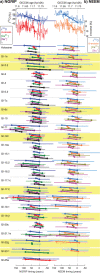The anatomy of past abrupt warmings recorded in Greenland ice
- PMID: 33833238
- PMCID: PMC8032679
- DOI: 10.1038/s41467-021-22241-w
The anatomy of past abrupt warmings recorded in Greenland ice
Abstract
Data availability and temporal resolution make it challenging to unravel the anatomy (duration and temporal phasing) of the Last Glacial abrupt climate changes. Here, we address these limitations by investigating the anatomy of abrupt changes using sub-decadal-scale records from Greenland ice cores. We highlight the absence of a systematic pattern in the anatomy of abrupt changes as recorded in different ice parameters. This diversity in the sequence of changes seen in ice-core data is also observed in climate parameters derived from numerical simulations which exhibit self-sustained abrupt variability arising from internal atmosphere-ice-ocean interactions. Our analysis of two ice cores shows that the diversity of abrupt warming transitions represents variability inherent to the climate system and not archive-specific noise. Our results hint that during these abrupt events, it may not be possible to infer statistically-robust leads and lags between the different components of the climate system because of their tight coupling.
Conflict of interest statement
The authors declare no competing interests.
Figures





References
-
- Voelker AHL. Global distribution of centennial-scale records for Marine Isotope Stage (MIS) 3: a database. Quat. Sci. Rev. 2002;21:1185–1212. doi: 10.1016/S0277-3791(01)00139-1. - DOI
-
- Capron E, et al. Synchronising EDML and NorthGRIP ice cores using d18O of atmospheric oxygen (d18Oatm) and CH4 measurements over MIS 5 (80–123 kyr) Quat. Sci. Rev. 2010;29:222–234. doi: 10.1016/j.quascirev.2009.07.014. - DOI
-
- Johnsen SJ, et al. Oxygen isotope and palaeotemperature records from six Greenland ice-core stations: camp Century, Dye-3, GRIP, GISP2, Renland and NorthGRIP. J. Quat. Sci. 2001;16:299–307. doi: 10.1002/jqs.622. - DOI
Publication types
LinkOut - more resources
Full Text Sources
Other Literature Sources
Miscellaneous

